Long-range shooting can be an equipment race. Sometimes, the better equipment decides the outcome of a match or bragging rights at the local range. We wanted to see if we could get into the game with a less-expensive rifle designed for long-distance shooting, the Savage Axis II Precision Rifle, $999, versus pricier models from Mossberg and Ruger, the MVP Precision Rifle, $1500, and the Custom Shop Precision Rifle, $2419, respectively. The Ruger Custom Shop Precision Rifle was in fact designed for the Precision Rifle Shooting Production Division, which has a maximum price point on rifles and optics to ensure competitors are more or less on the same playing field. It’s not a low-budget rifle by any means, but it is a good benchmark for what experienced shooters might want in a long-range production rifle.
As such, we assumed the Ruger would be tricked out for competition more than the Mossberg and Savage, but we wanted to determine if the extra cost and bells and whistles determined how accurate the rifles could shoot. After all, accuracy is where the rubber meets the road, or in this case, where the copper hits the steel. All the bells and whistles we found make it easier for the shooter to place an accurate hit. Features like a barrier stop, or a flat bottom handguard, muzzle brake and others allow a shooter to either set up steadier for a shot or allow shooters to see their hits or misses.
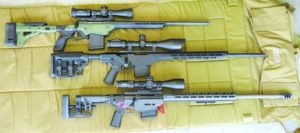
Optics, too, are a big consideration, and the rule is to spend as much on a scope as you would a rifle. We didn’t follow that adage because we were trying to be frugal with our long-range rifle build. We tried three different scopes we had in the shop, a Primary Arms GLx 4-16x50mm FFP scope ($750; PrimaryArms.com) with an illuminated ACSS-Apollo-6.5CR/.224V reticle; a Riton RT-S Mod 5 GEN 2 3-9x40mm scope ($340; KenziesOptics.com) with a SFP Dulex reticle; and a UTG 4-16x44mm scope ($199; Leapers.com) with an SFP 36-color Mil-dot reticle.
If long-range shooting is a game you’re considering, then we wouldn’t hesitate to purchase the Primary Arms scope. We feel the Riton is best suited for hunting situations, but it kept up with the long-range reticles in the UTG and PA. The UTG is inexpensive and a good choice if you are just getting started. We bore-sighted the rifles prior to range work.
In our experience, you don’t need a high-price ultra-tuned rifle to hit a target at distance. The smaller the target, however, and the smaller the group is when a more expensive rifle comes into play. What is mandatory for long-range shooting is a consistent rifle, ammo, and optic. You need to know where the rifle will hit. You also need to be prepared to fire the rifle from prone, sitting, kneeling, standing, and using whatever rest is available.
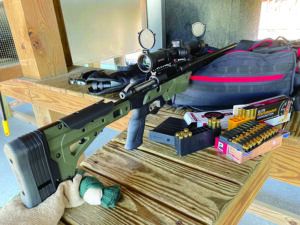
The barrel is the thing with long-range shooting, and the better the barrel, the better the results. The Ruger has a spectacular barrel, while the Savage barrel is excellent, and Mossberg barrel is very good. A rifle that is comfortable to shoot makes it easier for the shooter, so adjustable stocks and pistol-grip angles are important. All three of these rifles have adjustable stocks — length of pull and cheek riser, which are the minimum needed. The pistol grips are all AR-15 styles, so swapping out a grip to suit your needs is simple. We liked the Ruger’s and Mossberg’s Magpul grips because they had more of a vertical angle, which makes shooting prone more comfortable. The ability for the rifle to be set up for whatever shooting situation the terrain provides is important. For instance, all three rifles have M-Lok rails for attaching a bipod, the magazine wells are flared so you can brace them against a barrier and not worry about putting pressure on the magazine, which could cause feeding issues, and the bottom of the rails are flat so the rifle steadies easier when using a rest.
Our rifles were chambered in 6.5 Creedmoor, a popular round for long-range shooting that offers a flat trajectory, great ballistic coefficient, and minimal recoil. It’s accurate, too. Ammo used consisted of Hornady Match with a 140-grain Extremely Low Drag (ELD) Match bullets, SIG Sauer’s Elite Performance loaded with a 140-grain Open-Type Match bullets, and Prime brand cartridges loaded with a 130-grain hollowpoint boat-tail bullets. All of this ammo is capable of shooting one ragged hole at 100 yards.
How We Tested
We did not break the barrels in. We shot multiple strings and allowed the barrels to cool for a few minutes after each string. We were not patient with any of the rifles because we wanted to know if the barrel would retain accuracy after heating up. The first string was five shots at 50 yards with each ammo brand to get our dope. Next was another five-shot string with each ammo brand to tweak the zero at 100 yards, and then another three-shot string at 100 yards and 200 yards for accuracy. The temperature was 68 degrees with 10-mph wind speed. At 100 to 200 yards, wind speed was not much of a factor during our test. At farther distances, 10-mph wind would have us compensating for the drift. We used Thompson Targets HALO Scope Alignment Targets ($15/10; ThompsonTarget.com) with a 1-inch grid. These targets burst a halo around the bullet hole on impact, making it easy to see hits.
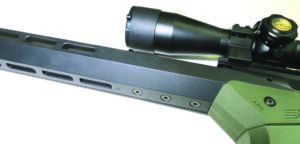
Test firing at 50, 100, and 200 yards was conducted sitting at a bench using our range bag as a rest and using a bipod. We used an old gym sock filled with sand for a toe bag. Sitting helped us get acquainted with the rifles. We also got our belly in the dirt and fired prone with both a bag and bipod. Shooting prone is the steadiest position you can shoot from, plus we were able to test the ergonomics of the rifles, such as comfort of the grip, access to the safety, ease in changing magazines, trigger consistency, access to scope turrets, stock comfort, ability to load a single round, etc.
Some of us just like to tickle steel at distance knowing we have the ability to read the wind and have a deep understanding of our equipment’s capabilities. Others like the juice of competition. We liked one of the three rifles the most, thinking it is competition ready out of the box, but is just as well suited for weekend shooters who like to go long. The other two rifles need some features before going muzzle to muzzle with competition-ready rifles. Here’s what else we found.
Gun Tests Grade: B+ (BEST BUY)
$999
The least expensive rifle in our match up by several hundred dollars was the Savage Axis II Precision, which uses the guts of the Axis II hunting rifle fitted to the bones of a Modular Driven Technologies (MDT) chassis made of aluminum and skinned with polymer. For an inexpensive rifle, this sample grouped like one of the more expensive rifles and nipped at the heels of the Ruger.
| Action Type | Bolt, 2 lugs, 90-degree lift |
| Overall Length | 42.5-43.5 in. |
| Barrel Length | 22 in., heavy, threaded |
| Twist Rate | 1:8 in. |
| Muzzle Device | None |
| Sights | None, optic ready |
| Overall Height | 7.3 in. |
| Weight Unloaded | 9.9 lbs. |
| Weight Loaded | 11.6 lbs. |
| Capacity | 10 |
| Stock | MDT chassis |
| Stock Length of Pull | Adjustable, 13.5 to 14.5 in. |
| Stock Drop at Comb | Adjustable |
| Stock Drop at Heel | Adjustable |
| Stock Buttplate | Adjustable |
| Bedding | NA |
| Action Finish | Matte black |
| Barrel Finish | Matte black |
| Magazine Type | Detachable box |
| Trigger Pull Weight | Adj., 2.25 to 5.0 lbs. |
| Safety | Manual ambidextrous thumb |
| Accuracy Guarantee | None stated |
| Warranty | 1 year |
| Telephone | (800) 370-0708 |
| Website | SavageArms.com |
| Made In | USA |
The Axis II barreled action is used in Savage’s budget-priced hunting rifles. It is built with a round receiver to cut production costs and only comes in a long-action configuration. Compared to a Model 110, the Axis II receiver is stiffer due to a smaller ejection port. A stiffer receiver, in theory, means better accuracy. Add the excellent AccuTrigger and the heavy 22-inch threaded barrel, and theory becomes reality.
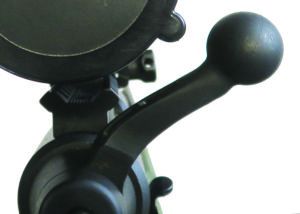
The MDT chassis is black-anodized aluminum with an olive drab-green injection-molded skin. The comb is adjustable via two setscrews, and the length of pull is adjustable via stacked spacers. You don’t need to take the rubber buttpad screws all the way out to remove the spaces. They are shaped like an “S” and twist out. We prefer the Ruger and Mossberg tool-less stock set up, but this is where Savage cut costs. A traditional-style fore end is used, albeit it is made of aluminum and wears M-Lok slots at 3, 6, and 9 o’clock positions. The pistol grip is an MDT Elite grip that is angled like a typical AR-15 A2 grip. The rubber MDT grip incorporates palm swells and is lightly textured and grooved. We thought the grip angle was too much for comfortable prone shooting and preferred the more vertical grips on the Ruger and Mossberg. We did note that we found a comfortable thumb rest on the edge of the chassis’s polymer skin.
The magazine release is a paddle located between the front of the trigger guard and the back of the magazine well. It was easily accessible with the trigger finger or the support hand. The magazine well flared out and far enough away from the magazine so the magazine was accessible even when you jammed the rifle up against a barrier. One MDT 10-round single-stack AICS-style polymer magazine is shipped with the rifle. We found loading single rounds into the action easy, even with the small ejection port.
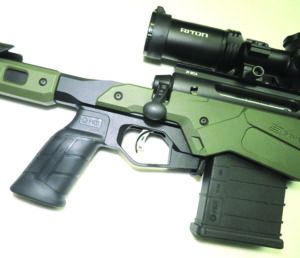
The adjustable AccuTrigger features a pivot pin held in place by a rubber O-ring inset into the chassis. This set up puts pressure on the trigger assembly and keeps it in place. We liked this trigger better than the Mossberg trigger. It also works the same; a center blade for take up, then a crisp break. Our trigger was about 4 pounds. Though that is a bit heavy for long-range work, we fired it as it arrived.
At 9 pounds naked, the Savage was the lightweight of the bunch. Add a scope, Picatinny rail for a bipod or other attachments, and muzzle brake, and the Savage will put on weight and be steadier.
We had a Riton RT-S Mod 5 GEN 2 3-9x40mm SFP scope in the shop. This scope features a simple duplex reticle, parallax dial, and covered turrets. Honestly, it is better suited for hunting than long-range shooting, but in our opinion, the glass was very clear edge to edge, and as you will see in the range data, the scope was not a liability on the Savage.
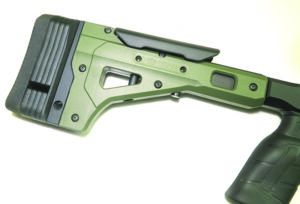
The bolt has two lugs with a 90-degree throw that gets very close to the scope’s eyepiece. We dialed in the Savage with five rounds and were quite impressed with the 100-yard groups. The smallest three-shot group was with SIG’s 140-grain OTM bullets, and it measured 0.28 inches. Nice. The smallest with the Prime and Hornady ammos were 0.68 and 0.66 inches, respectively. On average, the Savage grouped from 0.65 to 0.80 inches. Not bad for an “inexpensive” rifle. From an ergonomic and comfort standpoint, we felt the Ruger and Mossberg were better. We also found it difficult to see our hits with the Savage, and that’s due to its light weight and lack of a muzzle device.
Our Team Said: The Savage was quite accurate for a drop-in barreled-action-and-chassis set up. The rifle performed well, but we found the Ruger and Mossberg were easier and more comfortable to use. A muzzle brake, more vertical grip, and Picatinny rail are must buys to make this rifle even better. If you are a Savage fan, then this is a good option for long-range shooting on the weekends.
6.5 Creedmoor Range Data
To collect accuracy data, we fired three-shot groups from a bench using a rest. Distance: 100 yards. We recorded velocities using a ProChrono digital chronograph set 15 feet from the muzzle.| Hornady Match 140-grain ELD Match | Mossberg MVP Precision | Savage Axis II Precision | Ruger Custom Shop Precision Rifle |
| Average Velocity | 2766 fps | 2633 fps | 2700 fps |
| Muzzle Energy | 2379 ft.-lbs. | 2155 ft.-lbs. | 2267 ft.-lbs. |
| Smallest Group | 1.09 in. | 0.66 in. | 0.39 in. |
| Average Group | 1.11 in. | 0.67 in. | 0.56 in. |
| Prime 130-grain HPBT | Mossberg MVP Precision | Savage Axis II Precision | Ruger Custom Shop Precision Rifle |
| Average Velocity | 2777 fps | 2678 fps | 2781 fps |
| Muzzle Energy | 2226 ft.-lbs. | 2071 ft.-lbs. | 2233 ft.-lbs. |
| Smallest Group | 0.29 in. | 0.68 in. | 0.33 in. |
| Average Group | 1.09 in. | 0.80 in. | 0.53 in. |
| SIG Elite Performance 140-grain OTM Match | Mossberg MVP Precision | Savage Axis II Precision | Ruger Custom Shop Precision Rifle |
| Average Velocity | 2667 fps | 2580 fps | 2688 fps |
| Muzzle Energy | 2212 ft.-lbs. | 2070 ft.-lbs. | 2246 ft.-lbs. |
| Smallest Group | 0.67 in. | 0.28 in. | 0.18 in. |
| Average Group | 0.96 in. | 0.65 in. | 0.50 in. |
Value Guide: Short-Action Bolt Rifles
| Gun Name | Issue | Grade | Comments |
|---|---|---|---|
| CVA Cascade SB CR3914R 300 Blackout, $621 | Mar. 2022 | B+ | Our Pick. Most accurate of the three rifles tested, the CVA Cascade handles well and shoots well. |
| Savage Axis II 18819 300 Blackout, $385 | Mar. 2022 | B | Best Buy. While not as accurate as its Model 10 and 110 brothers, this Axis II performed well. |
| Ruger American Ranch Rifle 26968 300 Blackout, $529 | Mar. 2022 | C+ | Short and handy, but the action was rough initially. We graded it down for its mediocre accuracy. |
| Tikka T3X Varmint JRTXH312 223 Rem., $999 | Nov. 2021 | A | Our Pick. The most accurate rifle and perhaps the most versatile, we’d buy the Tikka T3X Varmint. |
| CZ Model 527 03019 223 Rem., $785 | Nov. 2021 | B+ | The trim receiver allowed the longest barrel, while maintaining a compact OAL. Outstanding trigger. |
| Ruger Hawkeye Predator 17122 223 Rem., $1359 | Nov. 2021 | B+ | A brushed stainless finish, a gorgeous three-color laminate stock, and a great trigger. |
| CVA Cascade CR3907C 350 Legend, $658 | Jul. 2021 | A | Our Pick. Outstanding trigger and tons of features on a value rifle. Tied with the Savage M110 Hog Hunter. |
| Masterpiece Arms MPA BA MPR PRO 6mm CM, $2499 | Apr. 2021 | A | Our Pick. A heavy, yet graceful beast of a rifle. The MPA is one of the most popular rifles on the PRS tour. |
| Christensen Arms MPR 801-03035-01 6mm CM, $1799 | Apr. 2021 | A- | Lightest sample included in this group, tested for a sport that prefers heavy rifles, and it still almost won. |
| Ruger Precision Rifle 18032 6mm CM, $1599 | Apr. 2021 | B+ | Good accuracy and dependability. We would have liked a crisper trigger and a wide, flat fore end. |
| Savage M110 Elite Precision 57558 6mm CM, $1999 | Apr. 2021 | B+ | Least accurate with the Federal ammo. Black Hills and Berger ammunition were much better. |
| Savage Arms 110 Hog Hunter 223 Rem., $599 | Feb. 2021 | A- | Oversized bolt, adjustable iron sights, adjustable LOP, a box magazine, and a threaded barrel. |
| Christensen Arms Ridgeline 801-06015-00 6.5 PRC, $1793 | Jan. 2021 | A | Our Pick. Accurate with factory ammunition — even better with reloads. Carryover winner from Nov. 2020. |
| Seekins Precision Havak Pro Hunter 2 0011710059-F 6.5 PRC, $1895 | Jan. 2021 | A | Outstanding accuracy with this round. We loved the stock and the trigger. |
| W’by Mark V Backcountry 6.5 RPM, $2249 | Jan. 2021 | B+ | Beautifully put together, but downrange accuracy wasn’t up to what we saw with other rifles. |
| Bergara Premier M’tn 2.0 BPR28-65PRC 6.5 PRC, $1999 | Nov. 2020 | A | A 100% carbon-fiber stock and trim 24-inch barrel make this a premier mountain rifle. |
| Browning X-Bolt Max LR 035438294 6.5 PRC, $1180 | Nov. 2020 | A | A little longer and a little heavier than our other test rifles. Beanfield rifle rather than a mountain rifle. |
| Savage M110 Hog Hunter 57534 350 Legend, $487 | Jul. 2020 | A | Our Pick. Compact size with a short, stiff, accurate barrel and a great trigger. Straight-wall chambering. |
| Ruger American Ranch Rifle 26985 350 Legend, $442 | Jul. 2020 | F/B+ | First sample failed when the bolt disassembled itself. The replacement rifle wasn’t all that accurate. |
| Winchester XPR Hunter 535741296 350 Legend, $635 | Jul. 2020 | A- | A full-length rifle that looked great and handled well; dropped off half a grade for its just-average accuracy. |




























Amazing blog! Is your theme custom made or did you download it from somewhere? A design like yours with a few simple adjustements would really make my blog stand out. Please let me know where you got your theme. Thanks a lot